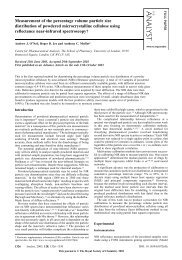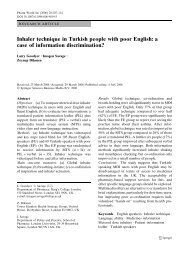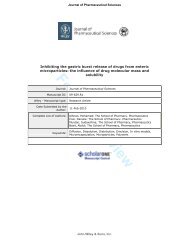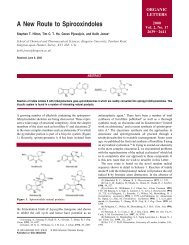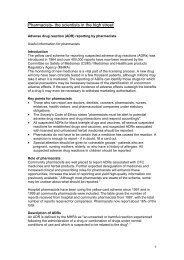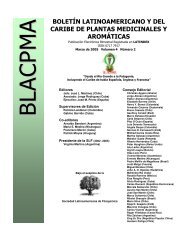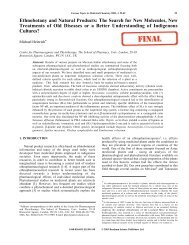SynArfGEF is a guanine nucleotide exchange ... - Pharmacy Eprints
SynArfGEF is a guanine nucleotide exchange ... - Pharmacy Eprints
SynArfGEF is a guanine nucleotide exchange ... - Pharmacy Eprints
Create successful ePaper yourself
Turn your PDF publications into a flip-book with our unique Google optimized e-Paper software.
easons for th<strong>is</strong> d<strong>is</strong>crepancy are unknown at present. However, since KIAA1110 <strong>is</strong> a partial 770<br />
amino acid protein corresponding to amino acids 439-1194 of rat synArfGEF, the complete<br />
structure of synArfGEF may be required for GEF activity toward Arf6.<br />
The PSD of excitatory synapses <strong>is</strong> known to contain a diverse array of GEFs and GTPase-<br />
activating proteins (GAPs) for small GTPases: Ras-GAP (synGAP) (Chen et al. 1998), Arf-GEFs<br />
(BRAG1, BRAG2b) (Sakagami et al. 2008, Murphy et al. 2006, Dosemeci et al. 2007), Arf-GAPs<br />
(GIT1 and PIKE-L) (Peng et al. 2004), Rac-GEF (Kalirin) (Penzes et al. 2000), Rap-GEF (cAMP-<br />
GEFII/Epac2) (Peng et al. 2004), and Rap-GAP (SPAR) (Pak et al. 2001). These regulatory<br />
proteins for small GTPases are proposed to modulate synaptic transm<strong>is</strong>sion by regulating the<br />
formation and maintenance of dendritic spines and synapses through the actin cytoskeleton<br />
reorganization (Zhang et al. 2003, Zhang et al. 2005, Vazquez et al. 2004, Penzes et al. 2001,<br />
Woolfrey et al. 2009). Among the BRAG family, IQ-ArfGEF/BRAG1/IQSEC2 was shown to localize<br />
at the PSD of excitatory synapses and form a protein complex with N-methyl-D-aspartate (NMDA)-<br />
type glutamate receptors, possibly via an interaction with PSD-95 (Dosemeci et al. 2007,<br />
Sakagami et al. 2008, Murphy et al. 2006) and insulin receptor tyrosine kinase substrate of 53 kDa<br />
(IRSp53) (Sanda et al. 2009) (Table 1). Mutations in IQSEC2 have recently been reported in<br />
patients with non-syndromic X chromosome-linked intellectual d<strong>is</strong>ability (XLID) (Shoubridge et al.<br />
2010). Interestingly, mutations in three out of four separate families with XLID lead to amino acid<br />
substitutions in the Sec7 domain and consequent reduction of the GEF activity toward Arf6,<br />
suggesting the functional significance of IQSEC2-Arf6 pathway in neuronal morphology or synaptic<br />
plasticity (Shoubridge et al. 2010). In sharp contrast, we show that synArfGEF localizes<br />
preferentially at postsynaptic specializations of inhibitory synapses. Th<strong>is</strong> major finding was<br />
confirmed by several independent lines of immunoh<strong>is</strong>tochemical evidence. To our knowledge, the<br />
only known regulator of small GTPases found at inhibitory postsynaptic specializations <strong>is</strong><br />
collyb<strong>is</strong>tin, a GEF for Cdc42, which was identified as an interacting protein for gephyrin by yeast<br />
two-hybrid screening (Kins et al. 2000). Thus, synArfGEF <strong>is</strong> l<strong>is</strong>ted as the second known regulator<br />
of GTPase that shows preferential localization at postsynaptic specializations of inhibitory<br />
synapses.<br />
What are the potential roles of synArfGEF at inhibitory synapses? The Arf family compr<strong>is</strong>es six<br />
structurally related members that regulate membrane trafficking and the actin cytoskeleton<br />
(D'Souza-Schorey & Chavrier 2006). Of the six Arf members, Arf6 <strong>is</strong> localized at the plasma<br />
membrane and endosomes, and regulates the endosome-plasma membrane traffic and<br />
remodeling of the actin cytoskeleton at the cell surface. At synapses, the submembrane<br />
cytoskeleton <strong>is</strong> known to regulate the number and dynamics of neurotransmitter receptors on the<br />
postsynaptic membrane, thereby modulating synaptic efficacy. At inhibitory synapses, both actin<br />
and microtubules has been shown to regulate the lateral diffusion and stabilization of glycine<br />
receptors and gephyrin (Charrier et al. 2006). In addition, gephyrin interacts with various regulatory<br />
proteins for the cytoskeleton, including polymerized tubulin (Kirsch et al. 1991), profilin (Mammoto



